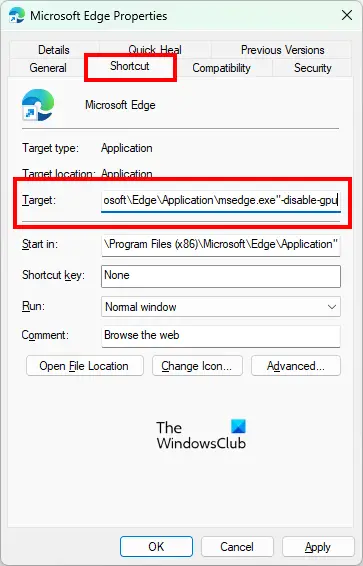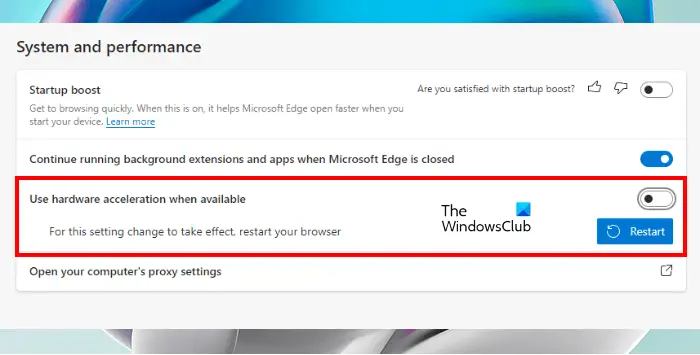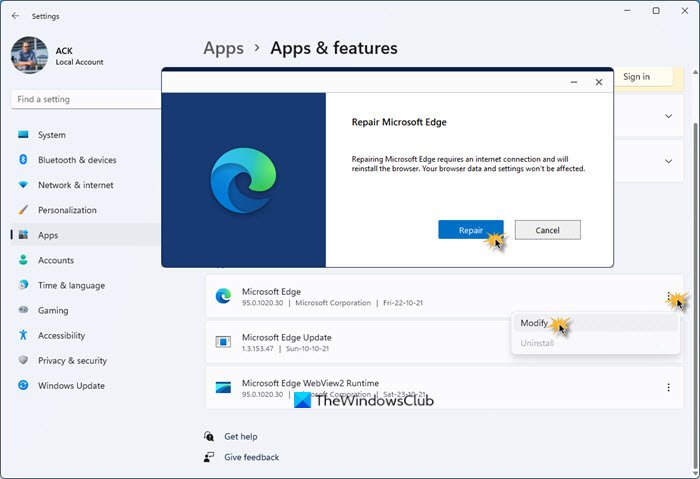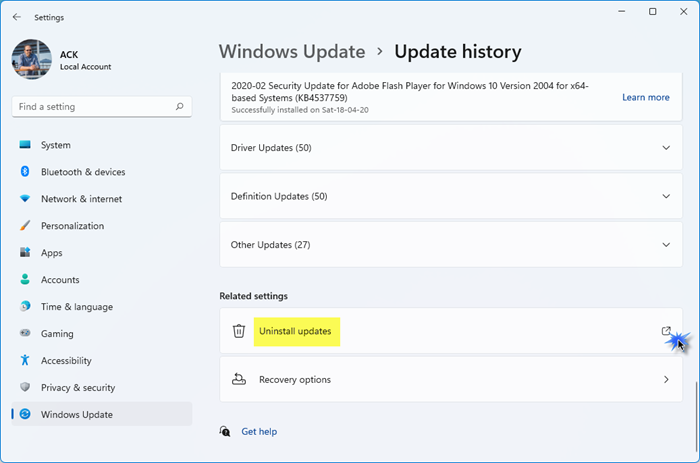If Microsoft Edge is showing a blank white screen when you launch it, the solutions provided in this post may help you fix the problem. The users who experienced this problem have stated that Edge displays a blank white or black screen for some time when they launch it. The problem appears every time they open the Microsoft Edge web browser. Some of them have tried clearing the Edge cache but that did not help.

Fix Microsoft Edge is showing blank white screen
Here is what you should do if Microsoft Edge is showing a blank white screen or a black screen after you launch it.
- Disable Hardware Acceleration
- Disable Edge extensions
- Scan your PC with a good antivirus and antimalware software
- Update or reinstall your Graphics card driver
- Reset or repair Microsoft Edge
- Create a new user account
- Uninstall the recent Windows Update
- Perform a System Restore
Let’s see all these solutions in detail.
1] Disable Hardware Acceleration
The most common cause of this problem is the Hardware Acceleration in Edge. If you have enabled this feature, disable it and then see if it fixes the problem. Because Edge is showing a blank white or black screen, you have to wait for some time until its interface becomes visible or you can try the following methods to make the edge interface visible.
- Press Win + R keys. This will launch the Run command box.
- Type
taskmgrand click OK. - When the Task Manager appears on your screen, select the Processes tab and double-click on the Edge browser to expand it.
- Now, right-click on one of the sub-tasks and select End Task.
- After that, terminate another Edge sub-task and repeat this process until its interface becomes visible. When its interface becomes visible, you can easily turn off the Hardware Acceleration.
If the above method does not work, follow the process written below until the Edge interface becomes visible.
Close Microsoft Edge and terminate all the Edge processes in the Task Manager. Now, right-click on the Edge desktop shortcut and select Properties.

In the Microsoft Edge Properties window, select the Shortcut tab. There, you will see the following path in the Target.
"C:\Program Files (x86)\Microsoft\Edge\Application\msedge.exe"
Replace the above path with the following:
"C:\Program Files (x86)\Microsoft\Edge\Application\msedge.exe" -disable-gpu
Now, click Apply and then OK. Launch Microsoft Edge. It should not show the blank white or black screen. Now, you can disable the Hardware Acceleration in Edge.
The steps to disable the Hardware Acceleration in Edge are as follows:

- Launch Microsoft Edge.
- Click on the three horizontal dots on the top right side and select Settings.
- Select System and performance from the left side.
- Turn off the switch next to Use hardware acceleration when available option.
- Click on the Restart button to relaunch Edge.
The above steps will disable the Hardware Acceleration in Edge. The issue should get fixed now. If not, try the next solution.
2] Disable Edge extensions
If the Edge interface becomes visible after performing the above fix, try to disable all extensions in Edge. Sometimes problems occur in a web browser due to an extension. If the issue is occurring due to a problematic extension, disabling it will fix the problem. After disabling all the extensions, restart Edge. See if the blank screen appears this time or not. If not, restart Edge one more time to confirm. If Edge does not show the blank screen, you have to identify the problematic extension. To do so, enable one of the extensions and restart Edge. If the problem reappears, that extension is the culprit.
3] Scan your PC with a good antimalware software
Scan your system using Windows Defender or any other good antivirus and antimalware software. This will let you know whether your system is infected by a virus or malware. Microsoft Safety Scanner is a free virus and malware removal tool. You can also use it. You may also use freeware AdwCleaner to scan your system.
4] Update or reinstall your Graphics card driver
Update your Graphics driver and see if that helps. If you recently updated your Display driver and then this issue started, maybe you want to roll back the display driver to its earlier version.
If updating or rolling back your Graphics card driver does not help, you can try uninstalling and reinstalling it. To do so, follow the steps listed below:

- Download the latest version of your graphics card driver from the manufacturer’s website.
- Now, open the Device Manager.
- Expand the Display adapters node and right-click on your graphics card driver.
- Select Uninstall device. After uninstalling your graphics card driver, your system will switch to the default display driver and you will not lose your display.
- Now, go to the location in File Explorer where you have downloaded the graphics card driver. Double-click on the installer file to install the driver manually.
- Restart your system after installing the graphics card driver.
5] Reset or repair Microsoft Edge
If the Edge shows graphics glitch and other issues, resetting or repairing it can fix the problem. The options to reset and repair Microsoft Edge are available in Windows 10 Settings. First, you should repair Edge. If this does not fix the problem, reset it.
In Windows 11 Settings, you will not find an option to reset Microsoft Edge. Hence, you have to repair it. The below-listed steps will help you repair or reset Edge in Windows 11:

- Open Windows 11 Settings.
- Go to “Apps > Apps & features.”
- Click on three vertical dots next to Microsoft Edge and select Modify.
- Now, click Repair.
6] Create a new user account
If after resetting or repairing Microsoft Edge, the issue still persists, some of the user account files might have been corrupted. In this case, creating a new Local Administrator user account can fix the problem. If Edge does not show a blank white or black screen in the new user account, you can transfer all your user data from the old profile to the new one.
To transfer your user data from your old user profile to the new user profile, do the following:
- Open File Explorer.
- Open your C drive and then open the Users folder. You will see all your user profile folders there.
- Now, open the old user profile folder and copy all the content inside it.
- After that, open the new user profile folder and paste the copied data there.
7] Uninstall the recent Windows Update

Sometimes, Windows Updates cause issues on a user’s system. In this case, uninstalling the recently installed Windows Update fixes the problem. If this is the case with you, you can uninstall the recent Windows Update from Windows 11/10 Settings or the Control Panel.
8] Perform a System Restore
System Restore is a tool developed by Microsoft that helps users protect and repair their Windows computers. After turning on this feature, you can create a System Restore Point so that you could use it to restore your system to the previous working state.

If you have created a System Restore Point before the problem started occurring on your system, use it to perform a System Restore and take your system back to the previous working state. This should work.
Read: Fix Can’t connect securely to this page error on Microsoft Edge.
How do I fix Edge black screen?
If you see the black screen in Edge after launching it, it might be occurring due to the Hardware Acceleration feature. If the feature is enabled in Edge, disabling it will fix the issue. Wait for some time until the interface of Edge appears. Once the Edge interface becomes visible, you can turn off the hardware acceleration. If this does not fix your problem, repair or reset Microsoft Edge.
Read: Microsoft Edge screen goes black when scrolling
How do you reset Microsoft Edge?
You can reset Microsoft Edge from Windows 10 Settings. The steps for the same are as follows:
- Launch Windows 10 Settings app.
- Go to “Apps > Apps & features.”
- Select Microsoft Edge and click Advanced Options.
- Now, click on the Reset button.
In Windows 11, an option to reset Edge is not available in Settings. Therefore, you can repair Edge or reset Microsoft Edge Settings to default.
Read next: How to fix Microsoft Edge Critical Error.